Standing out from the competition can be a significant challenge for any business. And one of the best ways to do that is co-marketing.
By joining forces with another brand, you can combine resources, expand your audience, and enhance your marketing efforts.
This approach not only amplifies your reach but also fosters a sense of collaboration that can resonate with your customers.
So, in this article, I’ll talk about the various forms of partner marketing initiatives and how they can elevate your business.
I’ll also go through the steps to build a co-marketing plan to identify and approach relevant brands for marketing partnerships. Let’s begin!
Disclaimer: If you buy any products through links on this site, I may earn a commission. But it doesn't make any difference to your cost, and it helps me keep this blog running. So you could always read my articles for free.
What is partnership marketing?
Co-marketing or partner marketing is a partnership between two companies. In this initiative, the companies collaborate to promote their existing products or services. And they do it in a way that is favorable to both of them.
For instance, Apple and EE had an online packaging deal for a long time. As part of this agreement, users of the telecom operator EE received a free Apple Music membership for half a year.
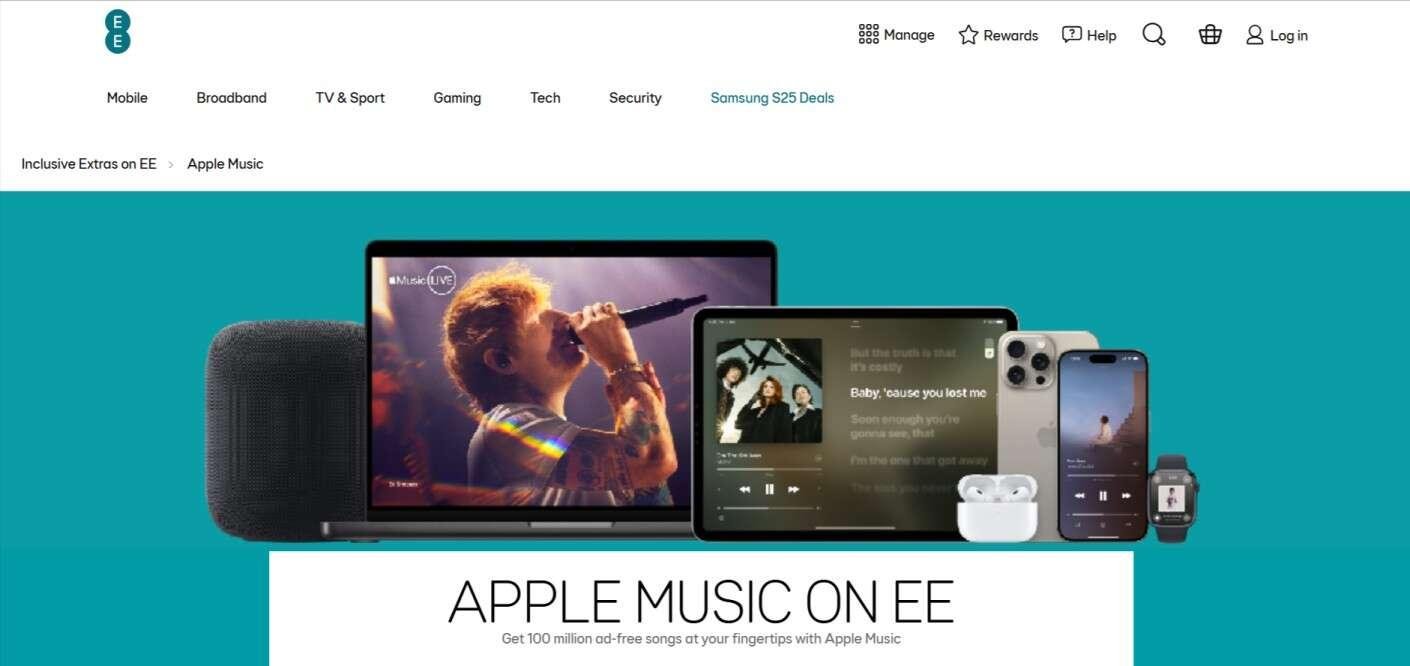
From EE’s perspective, providing its users with a free subscription to Apple Music made it more attractive in the market.
As for Apple, offering free membership to a premium service was a wonderful opportunity to promote its media service.
They expected the consumers to enjoy it to the point where they’d gladly purchase it after the initial offer of half a year expired.
This example shows that by developing a win-win marketing collaboration with a non-rival brand, each side can access new market segments economically.
What are the benefits of co-marketing?
Comarketing’s benefits include cost-saving, expanding your reach, engaging customers at the right time, developing your reputation, and bringing in repeat customers.
Partnership marketing can be an instantly effective and economical marketing method available to all kinds of companies. Its advantages include:
Reduce marketing expenses
If you execute a co-marketing campaign with a company, you usually split the expenses of the initiative between yourselves.
Partnership marketing allows you to save money by sharing assets like marketing investments, distribution avenues, connections, and human capital.
Expand your target market
Co-marketing lets you form a marketing collaboration with a company that has a similar customer profile but operates in a separate market segment.
For instance, Studio Proper had a collaboration marketing deal with Kingly, a Singaporean brand that manages technology operations for enterprises and government institutions.
Why? It let them enter the Singaporean industry and, at the same time, offered Kingly special rates on a variety of their items to include in its operations.

As seen from this example, a fresh initiative might allow you to win over a new target market. You can do this if you decide to collaborate with a company they already consider credible.
Engage consumers at the correct moment
A marketing collaboration with a compatible company allows you to promote your items or solutions at the right moment.
For example, if you bought airline tickets online, you might’ve seen promotional offers from motels showing up on the site.

Lodges anticipate that you might want a room during your travel. That’s why they form cross-marketing partnerships with specific flight companies to market their services.
Co-marketing not only provides benefits for you and your marketing partner but provides comfort to your consumers as well.
Develops your reputation
Partnership marketing can assist in building connections between new companies and the bigger, well-known ones.
In fact, Impact questioned over 400 co-marketers regarding the advantages offered by their campaigns. According to 50% of respondents, marketing partnerships are crucial for improving brand awareness.
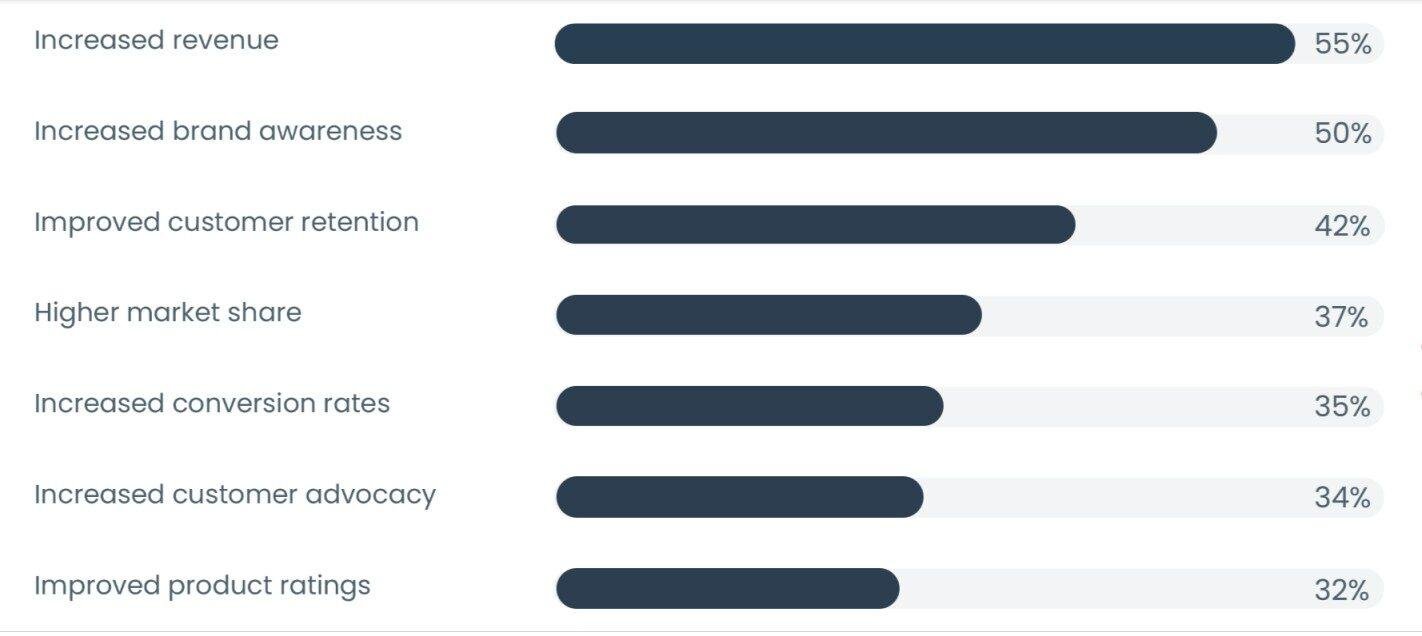
Your initiatives can potentially attract media attention as marketing partnerships are generally noteworthy, particularly if a recognized company is engaged.
Get repeat customers
Co-marketing brings you buyers who will like your offerings. This increases the possibility that they’ll stay with your company as they do with your cross-marketing partner.
As a result, it can assist you in growing your connections with useful contacts in areas of your field you previously had not reached out to.
For instance, tow truckers tactically collaborate with garages by having one another’s contact information.
This is because they both deal with vehicles that need servicing just at separate stages of the sales funnel.
Types of partnership marketing
Co-marketing has various forms, such as affiliate marketing, distribution partnerships, joint product partnerships, event sponsorships, and content marketing partnerships.
There are various types of marketing partnerships that companies can execute. These include:
Affiliate marketing
A type of online marketing in which companies partner with blogging professionals, influencers, or companies that have an identical target market.
This way, businesses get sales by offering a commission to their partners for each successful transaction.
Influencer marketing
This is similar to affiliate marketing. But in this case, the company is paying the partner to increase the reach and brand awareness of its product. They are not paying a commission for every new customer.
Distribution partnership
This form of cross-marketing consists of combining your partner’s offerings with yours. You can also let them package your items or solutions with theirs.
For example, Spotify and Uber thought of a marketing partnership in 2014. Passengers booking a cab on the Uber application got an exclusive offer to choose a pre-built Spotify mix for their journey.
Although this didn’t bring Uber fresh customers, it increased overall bookings and boosted interactions on the Spotify application.
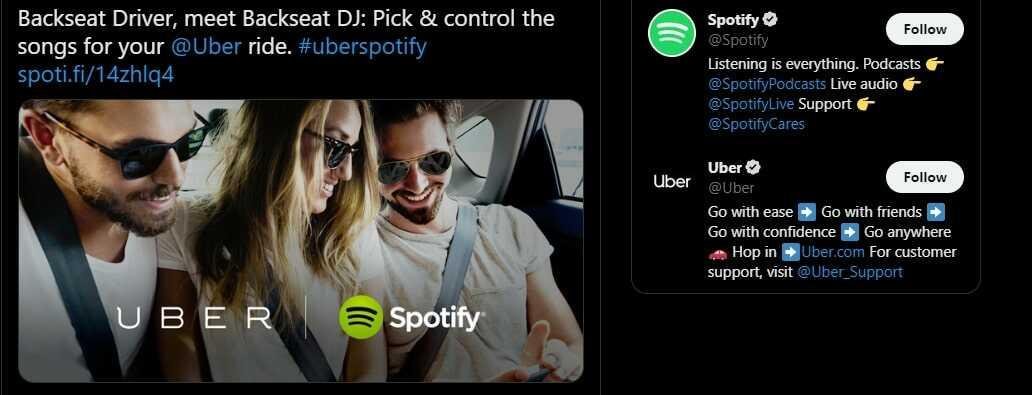
You can also offer free samples to suitable consumers via your marketing partner’s distribution. This will provide a pleasant gift to their customers and increase your brand recognition in exchange.
Joint product partnerships
This includes advertising another company’s items to your own target market and vice versa. This can be done via a newsletter initiative or an item combo.
For example, JetBlue provided its travelers with free pretzels that are supplied by Stellar Snacks.

Event sponsorships
This form of comarketing involves a company offering funds in return for something of similar worth. The offerings might consist of giveaways like providing a location, meals, lottery rewards, press endorsements, and advertising agreements.
In return, the sponsors usually get better brand visibility, accessibility to participants’ details, a chance to talk at the event, or cheaper entry.
For example, Coca-Cola has been partnering with the Olympics since 1928. One of its most notable partnerships was the #ThatsGold campaign of the 2016 Rio Olympic Games.

Content marketing partnerships
These partnerships consist of working together on content like showing up on one another’s YouTube channels, gift brochures, co-presenting podcasts, or posting content on one another’s Instagram accounts.
For example, if you run a combined lead-generation campaign that utilizes common assets, both you and your partner can use the email addresses collected.
Take the collaboration of Variety magazine and Easterseals. This initiative highlighted the lack of representation of individuals with impairments in the entertainment industry.

Co-branding
In this type of partnership marketing, two companies collaborate to launch a product that combines both of their brand elements. A great example of this is the Apple Watch Nike Edition.

How to build and execute a comarketing plan?
Co-marketing collaborations can form naturally or might need deliberate preparation and communication. It all hinges on what you’re looking for in a collaborator.
There are several approaches to developing your co-marketing tactics. But it eventually comes down to your condition, originality, and skill to propose the marketing partnership.
In any case, a partnership marketing proposal would come up short if it favors one party more than the other. A marketing partnership should be commercially logical and a good bargain for each side.
Any great marketing initiative requires sound planning. Here, I’ll explain how to create your co-marketing plan.
Develop connections ahead of time
A marketing collaboration is simple to establish if you already have a connection with your partner. If not, you can accomplish it by researching and contacting people via cold emails or social media.
There are numerous co-marketing possibilities available, but finding them requires the old-school approach of building connections and sales. You can use the following software to facilitate this process:
Clearbit Connect can assist you in getting the email address you require to approach the desired person.
A worksheet or a free CRM, such as Streak, can let you monitor the email opening rate, create and maintain your mailing list, and store layouts for future use.
SimilarWeb can assist you in analyzing a possible marketing partner’s site by evaluating the number of visitors, channels they are using, and additional indicators that suggest a strong collaboration.
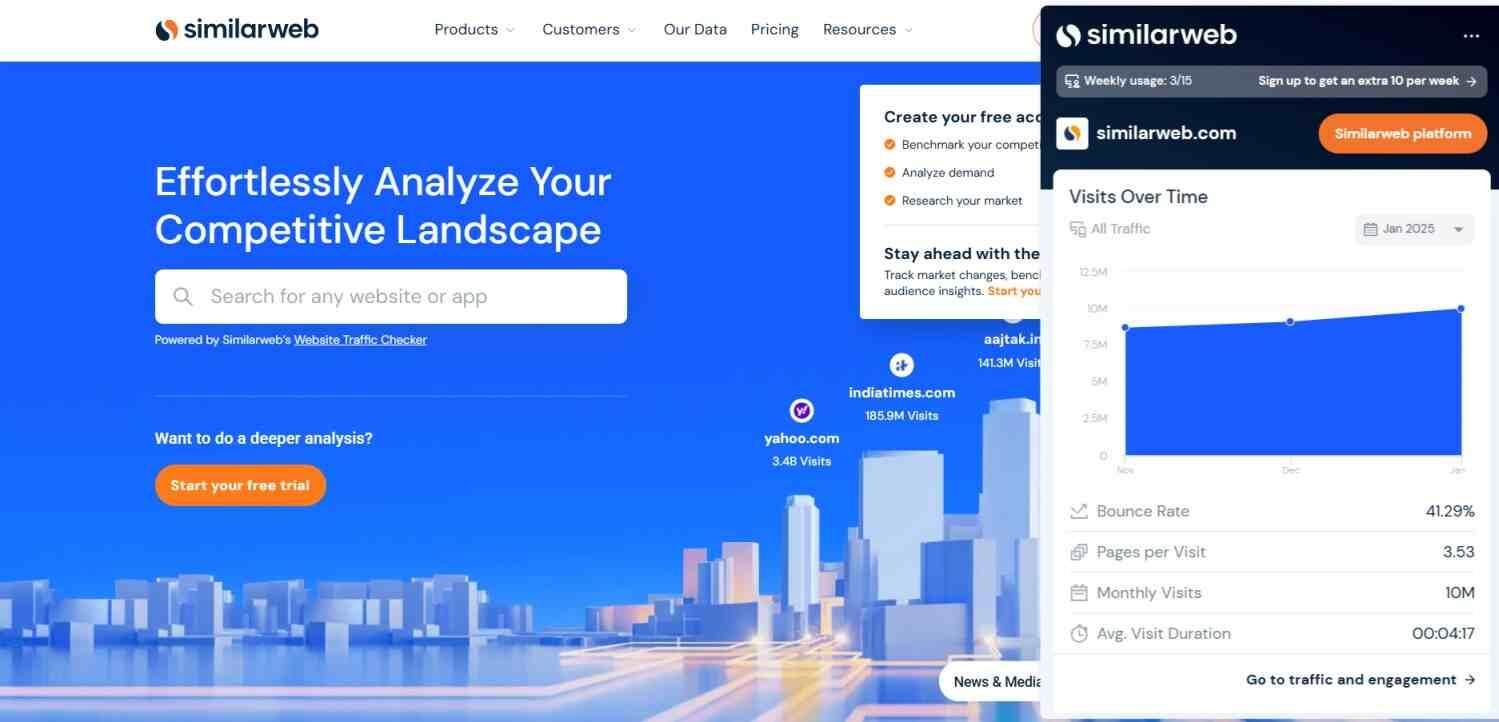
Calendly can help you avoid the hassle of organizing virtual calls for both you and your probable cross-marketing partner. Simply give them the URL to let them decide the date and time in your schedule that best suits them.
A marketing partnership is usually simple to establish when you already have a connection with a person within your partner’s company.
If this isn’t the situation, which is typical for a startup, you can still accomplish it by researching and contacting people via cold emails.
Evaluate possible collaboration prospects
To find a suitable match for partnership marketing, ensure that they don’t compete with you, have a large following, are not out of your league, and are interested in your offerings.
You certainly have numerous, or even more, potential co-marketing collaborators than you have rivals.
Examine for a suitable match prior to sending a proposal by checking your possible marketing partner on these factors:
- They don’t compete with you; rather they are compatible with your company
- They possess a large following (newsletter subscribers or social media followers)
- They are not “out of your league” (isn’t a turnoff with the correct proposal)
- You can offer things that they might be interested in (production abilities, complimentary or greatly marked down items, email subscribers, a target market, a social effect, reputation, talents, contacts, knowledge, and marketing resources)
Know your value
If you present an unfair marketing partnership proposal to brands you have no prior connections with, it would most certainly damage your relations with them (I have an inbox filled with selfish proposals to confirm this.)
Recognize the benefits they can provide you, but start the dialogue with what you can offer them.
Propose feasible comarketing options
Structure your cross-marketing proposal so that your marketing partner profits as well as you. Write down every advantage you possess and include it in your proposal.
You can talk about newsletter subscribers, monthly sales figures, and special bulk offers.
Before contacting other businesses about collaboration marketing, ensure that you have a solid plan for how exactly you’re expecting to partner with them.
With no specific suggestions, it’s doubtful that you’ll receive a response, much less a “Sure, let’s collaborate.”
As I previously mentioned, you must structure your proposal in such a manner that your marketing partner obviously profits. Write down every advantage you possess and include it in your proposal.
For example, a suitable starting point can be the number of your consumers and newsletter subscribers, monthly sales figures, and special bulk offers. Think about offers that’d get you excited if they had been proposed to you.
Once you’ve decided on the details, use this common pitch example to begin with, but remember to customize it to your prospective marketing partner:
Hey [First Name],
I’m [Your Designation] at [Brand Name], a [Company Bio].
I’m contacting you to discuss a possible collaboration with [Partner Brand’s Name] because [Give A Personalized Reason].
[Your Brand’s Name] possesses [Highlight Your Advantages]. Because you’re [Highlight Similarities], I figured you’d be willing to work together.
Below are a few possibilities that I’ve thought of:
- [Present First Comarketing Suggestion With Obvious Benefits]
- [Present 2nd Comarketing Suggestion With Obvious Benefits]
Would you be open to a 20-minute virtual meeting [Your Calendly URL] to explore a win-win collaboration?
Thank you for your time. I hope to hear from you soon.
[Email Signature]
Define common objectives
Tell your potential marketing partner your objectives and pay attention to theirs to determine compatibility. When both of you aim for the same goals, your efforts have a better payoff.
It’s crucial to define what you want to achieve from a collaboration marketing campaign prior to getting into one.
Comarketing is effective if it emphasizes equal exchange in order to create an agreement that benefits each side involved, and not just your own.
Tell your potential marketing partner your objectives and pay attention to theirs to determine whether they are compatible with one another.
When both you and your marketing partner are aiming for the same goals, your efforts have a better payoff.
An excellent marketing partnership must be advantageous to each party: you, the company you collaborate with, and your consumers.
For example, Homesick’s fragrant candles are based on the memorable scents of certain locations like New York City. This provides a lot of possibilities for clever, innovative partner marketing opportunities.
Among the most innovative ones till now is Homesick’s co-marketing partnership with Lucasfilm. These companies signed a collaboration marketing deal to create a one-of-a-kind Star Wars candle selection.
The candles contained the aromas of imaginary worlds from a universe deep and distant.
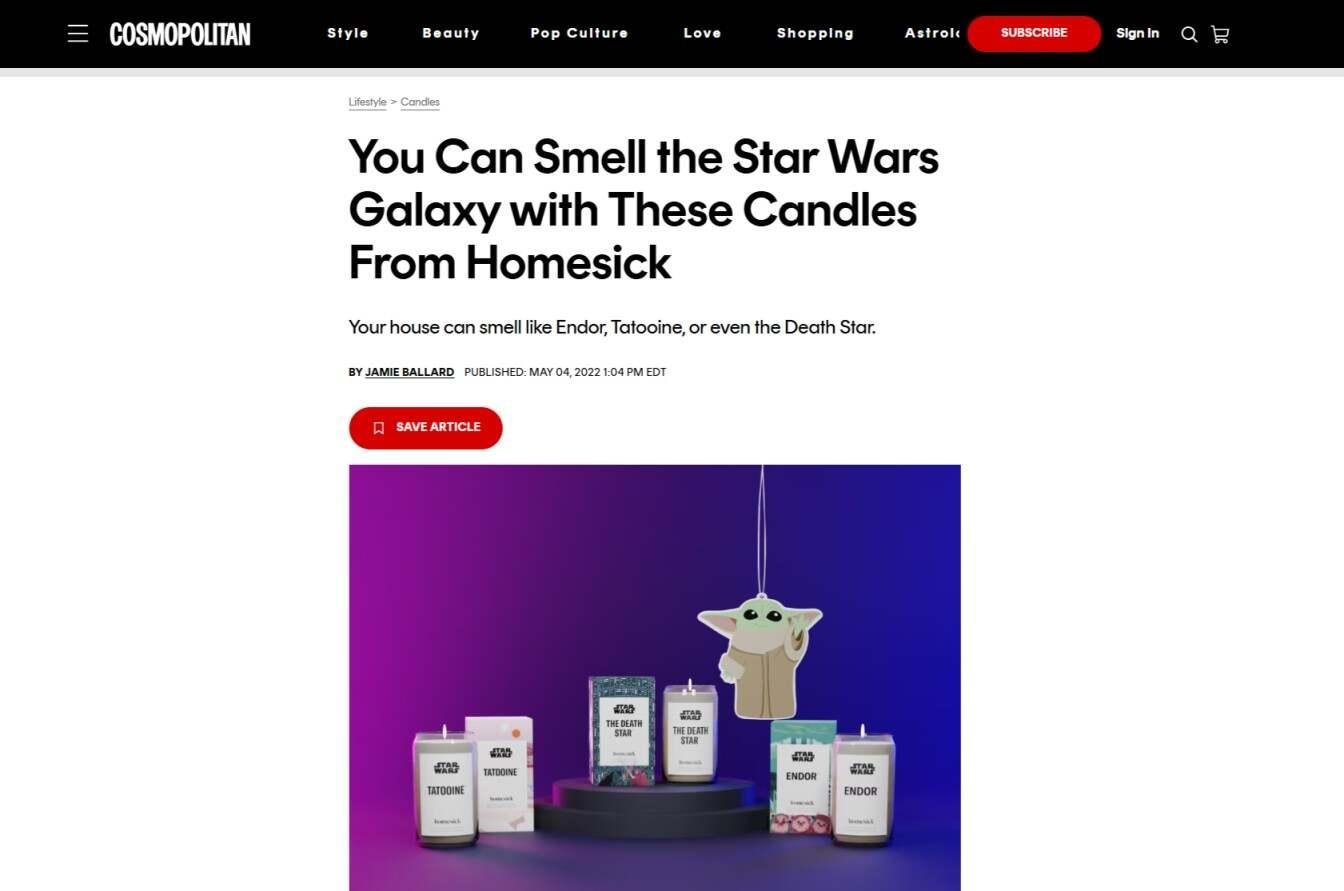
The collaboration was also featured in major magazines such as Cosmopolitan and Mashable.
At the same time, Lucasfilm was able to give life to a part of its iconic sci-fi series with the help of Homesick’s production skills.
Discuss specifics of the partnership
Define the terms and goals of your collaboration, including its details, profit sharing, roles, materials, capital, objectives, schedule, and evaluation. Having these specifics in an agreement is also a smart option.
After you’ve discovered a compatible partner marketing company that is eager to work with you, set up a meeting to define the terms of your comarketing collaboration.
Although a verbal agreement is sufficient for numerous co-marketing partnerships, having it on paper or preparing an agreement for signing is a smart option.
This is particularly important for initiatives that include multiple aspects like revenue distribution or manufacturing new products together.
In the discussion stage, you must figure out:
- The details of the initiative and how everyone involved would profit
- The roles and duties of each party so that all the tasks that must be completed do get so
- The materials and capital every side has to contribute
- The objectives of the cross-marketing partnership so that you and your partner are on the same page regarding the results
- The schedule of the marketing collaboration and the duration of the contract
It’s crucial to specifically define accomplishments for every party and how they are going to be evaluated, particularly if the objective is getting new consumers.
Co-create content
Research content topics and choose the type of content you want to create that is appropriate for your and your partner’s target groups.
Content is essential to each marketing activity, including partnership marketing campaigns.
In fact, 81% of respondents in CMI’s Content Management and Strategy Survey 2021 said that their company sees content as an integral part of their marketing plan.

You and your collaborator might have great individual content, but it will be ineffective if it is not related to your joint efforts.
This implies that you should generate fresh content in collaboration to increase the worth your content offers to customers.
Case in point: Flipboard’s collaboration marketing with Airbnb. Airbnb was a popular brand, but the social media platform Flipboard was not as well-known till this excellent marketing partnership.

Tailored Airbnb content created for people using Flipboard generated millions of site visits and thousands of fresh social media fans.
Research content topics and choose the type of content you want to create to ensure that it is appropriate for your and your partner’s target groups.
Not just that. You should integrate your content efforts with your objectives. With the correct metrics, you can produce content that will allow you to meet your business objectives.
Set a timeframe
You and your marketing partner must determine the dates of promotion by creating a defined schedule to generate maximum interest. This allows everyone involved to understand each other and finish their assignments promptly.
Create a defined schedule for your cross-marketing initiative. This allows everyone involved to understand each other and finish their assignments and duties promptly.
Both you and your marketing partner must determine the days of promotion that are ideal to generate maximum interest from each of your target markets.
For example, your companies might have a certain period or time of the year that normally sees greater interaction or a boost in revenue.
Find each partner’s strong and weak points
Each side has its own strong and weak points. Consider these when delegating tasks and responsibilities for your comarketing campaign.
Every side will have its strengths and weaknesses. Talk about these aspects with your marketing partner to decide what everyone can offer.
After recognizing your strong and weak points, you can delegate responsibilities and assignments properly.
For example, say you run a podcast with a huge audience. In that case, your company can handle the content generation aspect of the marketing collaboration to simplify the operations.
Draft a partnership contract
Make sure you have a reliable collaboration by having a contract on paper. It should contain points like objectives, subjects, deadlines, advertising strategies, monitoring activities, rights to content, and distribution channels
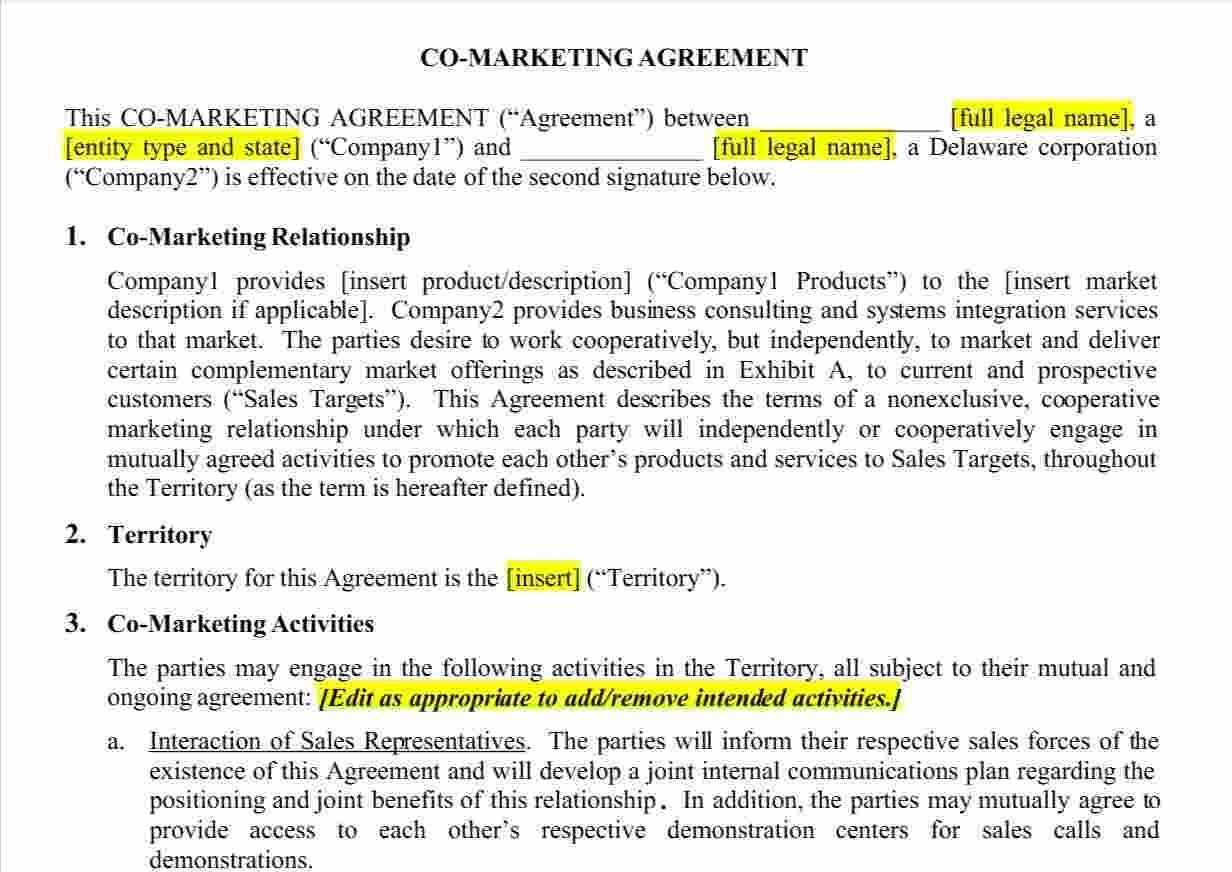
Your plans cannot come to fruition until each side commits to them. Make sure you have a reliable collaboration marketing campaign by having a contract on paper at the early stages of your partnership.
So you can reference it in case there are any communication issues. Your contract must contain points such as:
- Objectives
- Subjects
- Deadlines
- Advertising strategies
- Monitoring activities
- Rights to the content and resources
- Distribution channels for content
After you’ve completed these steps, you can start with your comarketing efforts.
Track campaign performance
Evaluate the performance based on the form and goals of your partnership marketing using means such as UTM codes, promotional coupons, hashtags, backlinks, and referral visits.
The benefits of your initiatives must be negotiated with your marketing partner as well, specifically if the objective is to acquire consumers and revenue.
How you evaluate the performance will be based on the form of your collaboration marketing and its objectives. For example, here are a few objectives and the ways to track them:
- Visits generated through common marketing avenues can be measured using Urchin Tracking Module (UTM) codes.
- Consumers and revenue generated can also be monitored using UTMs or by exchanging program-specific promotional coupons.
- Social media interactions can be tracked with your company’s hashtag or your marketing partner’s hashtag on social platforms.
- Media coverage, particularly if you’ve issued an announcement, could be evaluated using backlinks and referred visits or by creating a Google Alert.
Common questions about comarketing
Below are the answers to the most frequently asked questions about partnership marketing.
How is co-marketing different from traditional marketing campaigns?
Co-marketing differs from traditional marketing because it involves a higher level of collaboration among the businesses involved. Both parties choose to share their resources, assets, or audiences to achieve mutually beneficial goals.
How do I find a co-marketing partner?
To launch a partner marketing initiative with another brand, you can use online business directories or a search engine.
The idea is to look for businesses that offer products or services related to yours, as long as they are not your direct competitors. You can then contact the marketing decision-makers in these companies and pitch a partnership proposal.
What’s the difference between co-branding and co-marketing?
Co-branding happens when two or more brands collaborate to promote a single product or service. In contrast, co-marketing is about two or more businesses promoting the products of each party in a single campaign.
Final thoughts on comarketing
Co-marketing is not just a trend; it’s a strategic approach that can elevate your brand in ways you might not have imagined.
By collaborating with other businesses, you can unlock new opportunities, share costs, and connect with a broader audience.
As you consider implementing co-marketing initiatives, remember that the key lies in finding the right partnerships and creating mutually beneficial strategies.
Embrace this collaborative spirit, and you’ll likely see remarkable results that can propel your brand forward.
Did I miss anything? Did you try these steps? Do you have any questions or comments? Share your thoughts below in the comments section.

